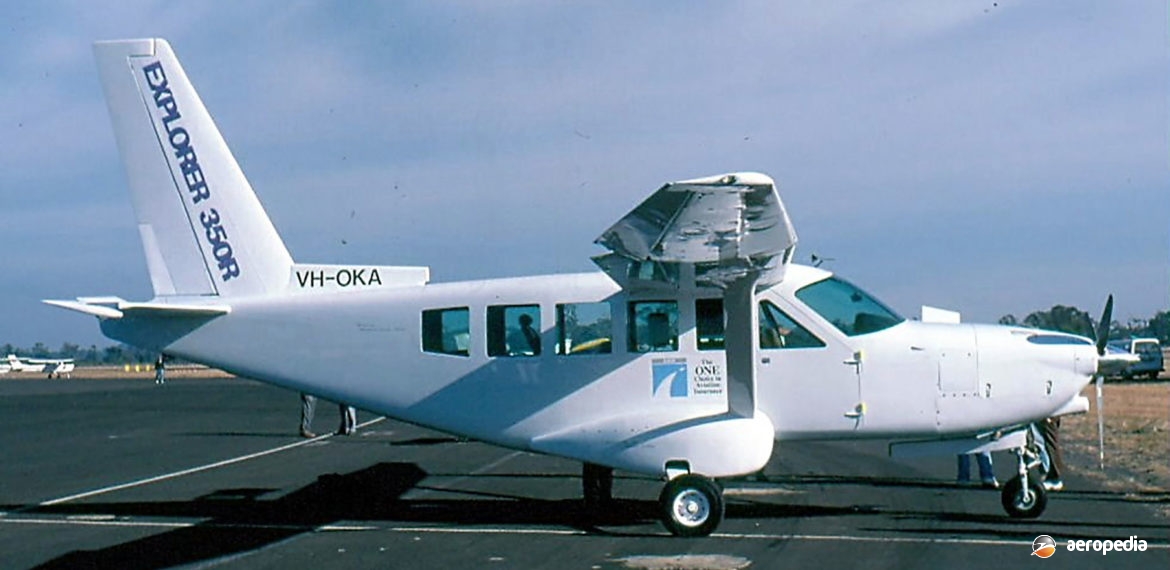Photograph:
AEAR Explorer prototype VH-OKA (c/n 350-001) at Mangalore, VIC in April 1998 (David C Eyre)
Country of origin:
Australia
Description:
Utility transport
Power Plant:
One 261 kw (350 hp) Continental TSIO-550-E3B six-cylinder turbo-supercharged horizontally-opposed air-cooled engine
Specifications:
- Wingspan: 14.41 m (47 ft 4 in)
- Length: 9.69 m (31 ft 9 in)
- Height: 4.72 m (15 ft 6 in)
- Wing area: 18.36 m² (197.6 sq ft)
- Max speed: 383 km/h (238 mph)
- Max cruising speed: 268 km/h (166 mph)
- Stalling speed flaps down: 96 km/h (60 mph)
- Max rate of climb at sea level: 244 m/min (800 ft/min)
- Service ceiling: 9,145 m (30,000 ft)
- Range with max fuel at max cruise with allowances:2,037 km (1,266 miles)
- Empty weight: 1,360 kg (3,000 lb)
- Loaded weight: 2,177 kg (4,835 lb)
History:
The Explorer was an Australian entry into the light utility transport market, the prototype Explorer 350R being designed by Australian Aeronautical Engineers (AEA) Pty Ltd at Jandakot, WA. The prototype, known as a proof-of-concept aircraft (VH-OKA – c/n 350-001), flew for the first time on 23 January 1998, and in April that year it was demonstrated in the eastern States, later going to the United States for a sales tour and demonstration at the EAA aviation event at Oshkosh in Wisconsin.
Designed to seat eight to ten passengers, the Explorer 350R had an 816 kg (1,800 lb) payload, an economical cruising speed of 259 km/h (161 mph), a large cargo door for freight loading, and two crew doors. It had a rugged retractable undercarriage, the nose leg pivoting beneath the engine bearers and folding to the rear, and the main legs stowed in side pods on the fuselage and thus did not encroach into the cabin.
The Explorer was aimed at the market between the Cessna 210 and the Cessna Caravan. It had a composite fuselage, high-lift aluminium wing, and an advanced STOL aerofoil. A high-wing provided access to the cargo door, giving passengers a good view, and protecting those loading freight from direct sunlight in the Australian climate. The wing had struts and had no spar carry-through across the cabin, thus providing a 5.1 m² (55 sq ft) cabin floor. The fuselage had an aluminium primary structure, and was clad with carbon fibre honeycomb panels.
In May 1998 the registration of the prototype was changed to VH-ONA. In 1998 Explorer Aircraft was established in Colorado, USA to develop the series, later moving to Houston in Texas. The prototype was there fitted with a Pratt & Whitney PT6-135B engine and became the prototype of the Explorer 500T model, flying in this configuration for the first time on 9 June 2000. It made its public debut at the EAA event at Oshkosh in August 2000. Subsequently it was re-engined with an Orenda OE 600A VEE-8 piston engine and became the prototype of the 500R model. In the United States the prototype of the series, formerly VH-ONA, became N718DA.
Production was to begin in North America in 2002 and development is reported to have continued, advertising continuing in 2018. A future variant was the 750T, which was a stretched model fitted with a 597 kw (800 hp) Pratt & Whitney PT6-60A engine with an 1,814 kg (4,000 lb) payload, or up to sixteen passengers, and consideration was given to installing a Walter turboprop.

